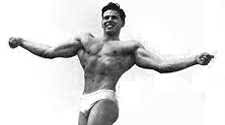Roland Joseph Essmaker: The Real Story of the First AA U Mr. America

The Full Story Behind the Scenes of the 1st AAU Mr. America
In the span of 11 months, from June 1939 to May 1940, three men were awarded the title of Mr. America, and each has defenders who claim he was the
"first" AATJ Mr. A. The trail to finding out who really got there first is not as easily trod as simply examining the chronology of events, which
occurred as follows: On June 10, 1939, Bert Goodrich won. On July 4, 1939, Roland Essmaker won. On May 25, 1940, John Grimek won.
By sifting through the records, we can determine the rightful titleholder and discount the others. And therein lies the tale. The fact is, Goodrich's
victory took place at an event that was called America's Best Physique Contest, and it was held in Amsterdam, New York. The important point here is that
this contest allowed professionals to compete against amateurs. Thus, the AAU, which stands for Amateur Athletic Union, did not stage the contest nor
did it sanction it. This negates the claim that Bert was the first AAU Mr. America.
In any case, 24 days later, on Independence Day, another Mr. America contest was staged in Chicago in connection with the '39 Senior National
Weightlifting Championships. The front cover of that event's printed program declared it to be an AAU-sanctioned competition. The physique contestants
were required to compete in the weightlifting event, and it was the first official AAU Mr. America contest ever held.
There are several pieces of evidence besides the printed program that connect the contest to the AAU, including a feature on Essmaker's feat in the
company newsletter when he worked for the Richmond Cord Department. Roland Joseph Essmaker was only 23 years old when he won the Mr. America, so it was
with youthful enthusiasm that he approached Bob Hoffman, the editor of Strength & Health magazine, on the day after the contest and wondered aloud if S&H
would be shooting a pictorial about the winner and if he should hang around to pose. The stunning answer was, No, run along home. We won't be needing you
to.
It was an anticlimactic moment, the first of many he'd experience as he realized his victory would be treated lightly and would be clouded. It appears
that Hoffman had interests in promoting Grimek as the first AAU ML America over the years, so it must have been a monumental copy editor's error-from
Hoffman's point of view-to allow the caption on page 26 of the September '62 issue of S&H to say, "By his own admission, the first AAU ML America is the
least photographed of all the Mr. Americas.' Roland Essmaker, who won the title in 1939 in Chicago, now resides in Paramount, California."
That same magazine had printed a similar acknowledgment in the February '59 issue. By 1982, however, matters had become less precise, and Roland wrote
letters to Grimek, who was by then editor in chief of Muscular Development, and Bob Crist, who was the AAU Mr America committee chairman, trying to clear
things up. He received no replies.
Essmaker was not a husky teenager. "I weighed 129 pounds at the time I joined the CCC [Civilian Conservation Corps] in November 1933," he recalled. By the
time he was discharged 13 months later, he had put on 19 pounds.
His father had bought a copy of Strength & Health, which Roland read from cover to cover. In those days the $10, 205-pound Milo barbell set was too expensive
for Essmaker, so he used window sash weights for dumbbells. He fashioned a chinup bar on the back porch and performed situps and one-leg squats. When he could
finally afford it, he purchased the Milo set.
Roland's progress was slow, deliberate and hard earned. By reading S&H and old copies of Bernarr MacFadden's Physical Culture magazine, which were available
at his father's chiropractic office, he increased his knowledge. Although he never had a gym membership per se, he trained at various locations as he toured
America, posing for art classes.
"While modeling at the John Herron Art Institute in Indianapolis, Indiana, I trained at Fred Hofmeister's gym," Essmaker related. "While modeling at the University
of Illinois in Urbana, I used the university gym. While modeling at Columbia University in New York City, I used Tony Sansone's gym and Sig Klein's."
It was Hofmeister, who had competed against Goodrich three weeks earlier, who urged Roland to enter the '39 Mr. A contest. In April 1942 Roland went on a blind
date with a Virginia Stanley. They were married on October 31, 1942, in Medford, Oregon, while he was stationed at Camp White. A move to Los Angeles in August
1946 saw the opening of Roland's gym in Hollywood, but he sold the place nine months later. He attended the Dan Martin School of Radio and TV in Hollywood in
1950 and '51, and he worked for radio stations in Chino, Pomona and San Bernardino, California.
Training at home again in Paramount, Roland kept a low profile. By '62 he was working for Autonetics, a division of North American Aviation, running the firm's
gym three days a week after he'd finished his regular shift as a printer. He later worked as a pressman at Container Corp. of America and retired in 1973.
Although physique historian David P. Willoughby described Roland as one of the less massive of the Mr. As, his development was obvious to his co-workers: '"Yes, my
fellow workers knew about my title," he said. "I rarely spoke of it and only when asked. An advanced-body physique is obvious. A couple of companies that I worked
for published the information in their plant magazines."
In 1995 Roland and Virginia and their two daughters will celebrate the couple's 53rd wedding anniversary, as well as the 56th anniversary of Roland's becoming the
first AAU Mr. America.